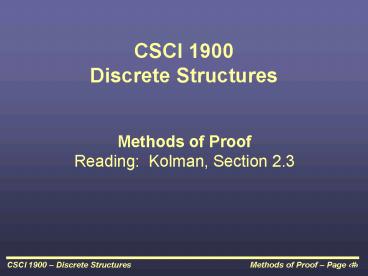CSCI 1900 Discrete Structures - PowerPoint PPT Presentation
Title:
CSCI 1900 Discrete Structures
Description:
If result is a tautology, then the implication p q represents a universally ... The next shows that this is a tautology and therefore is universally valid. ... – PowerPoint PPT presentation
Number of Views:50
Avg rating:3.0/5.0
Title: CSCI 1900 Discrete Structures
1
CSCI 1900Discrete Structures
- Methods of ProofReading Kolman, Section 2.3
2
Past Experience
- Up to now weve used the following methods to
write proofs - Used direct proofs with generic elements,
definitions, and given facts - Used proof by cases such as when we used truth
tables
3
General Description of Process
- p ? q denotes "q logically follows from p
- Implication may take the form (p1 ? p2 ? p3 ? ?
pn) ? q - q logically follows from p1, p2, p3, , pn
4
General Description (continued)
- The process is generally written
as p1 p2 p3 pn ?q
5
Components of a Proof
- The pi's are called hypotheses or premises
- q is called the conclusion
- Proof shows that if all of the pi's are true,
then q has to be true - If result is a tautology, then the implication p
? q represents a universally correct method of
reasoning and is called a rule of inference
6
Example of a Proof based on a Tautology
- If p implies q and q implies r, then p implies r
- p ? q q ? r ?p ? r
- By replacing the bar under q ? r with the ?,
the proof above becomes ((p ? q) ? (q ? r)) ? (p
? r) - The next slide shows that this is a tautology and
therefore is universally valid.
7
Tautology Example (continued)
8
Equivalences
- Some mathematical theorems are equivalences,
i.e., p ? q. - The proof of such a theorem is equivalent with
proving both p ? q and q ? p
9
modus ponens form (the method of asserting)
- p p ? q ?q
- Example
- p a man used the toilet
- q the toilet seat is up
- p ? q If a man used the toilet, the seat was
left up - Supported by the tautology (p ? (p ? q)) ? q
10
modus ponens (continued)
11
Invalid Conclusions from Invalid Premises
- Just because the format of the argument is valid
does not mean that the conclusion is true. A
premise may be false. For example Acorns are
moneyIf acorns were money, no one would have to
work?No one has to work - Argument is valid since it is in modus ponens
form - Conclusion is false because premise p is false
12
Invalid Conclusion from Invalid Argument
- Sometimes, an argument that looks like modus
ponens is actually not in the correct form. For
example - If tuition was free, enrollment would
increaseEnrollment increased?Tuition is free - Argument is invalid since its form is
- p ? q q ?p
13
Invalid Argument (continued)
- Truth table shows that this is not a tautology
14
Indirect Method
- Another method of proof is to use the
tautology (p ? q) ? (q ? p) - The form of the proof is q q ?
p ?p
15
Indirect Method Example
- p My e-mail address is available on a web site
- q I am getting spam
- p ? q If my e-mail address is available on a web
site, then I am getting spam - q ? p If I am not getting spam, then my e-mail
address must not be available on a web site - This proof says that if I am not getting spam,
then my e-mail address is not on a web site.
16
Another Indirect Method Example
- Prove that if the square of an integer is odd,
then the integer is odd too. - p n2 is odd
- q n is odd
- q ? p If n is even, then n2 is even.
- If n is even, then there exists an integer m for
which n 2m. n2 therefore would equal (2m)2
4m2 which must be even.
17
Proof by Contradiction
- Another method of proof is to use the tautology
(p ? q) ? (q) ? (p) - The form of the proof is p ? q q ?p
18
Proof by Contradiction (continued)
19
Proof by Contradiction (continued)
- The best application for this is where you cannot
possibly go through a large number (such as
infinite) of cases to prove that every one is
true.
20
Proof by Contradiction Example
- Prove that ?(2) is irrational, i.e., cannot be
represented with m/n where m and n are integers.
- p ?(2) is a rational number
- q There exists integers m and n for every
rational number such that the rational number can
be expressed as m/n - p ? q If ?(2) is a rational number, then we can
find m and n - The goal is to prove that we cannot find an m and
an n, i.e., q is true.
21
Proof by Contradiction Example (continued)
- Assume (m/n)2 2 and that m and n are in their
most reduced form. This means that m2 2n2. - Therefore, m must be even and m2 must contain 22
- Therefore, n must be even too.
- Therefore, m/n is not in the most reduced form
(we can pull a 2 out of both m and n). - This is a contradiction! Cannot come up with m
and n, i.e., q is true - Therefore, p is true and ?(2) must not be a
rational number






























